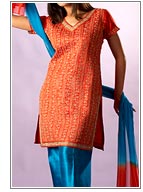designer punjabi salwar kameez Biogarphy
source(google.com.pk)In the history of Indian clothing the sari is traced back to the Indus Valley Civilisation, which flourished during 2800–1800 BC around the western part of the Indian subcontinent. The ancient stone inscription from Gangaikonda Cholapuram in old Tamil scripts has a reference to hand weaving. In ancient Indian tradition and the Natya Shastra an ancient Indian treatise describing ancient dance and costumes, the navel of the Supreme Being is considered to be the source of life and creativity, hence the midriff is to be left bare by the sari.Sculptures from the Gandhara, Mathura and Gupta schools 1st–6th century AD show goddesses and dancers wearing what appears to be a dhoti wrap, in the "fishtail" version which covers the legs loosely and then flows into a long, decorative drape in front of the legs. No bodices are shown. The two-piece Kerala mundum neryathum mundu, a dhoti or sarong, neryath, a shawl, in Malayalam is a survival of ancient Indian clothing styles. The one-piece sari is a modern innovation, created by combining the two pieces of the mundum neryathum.It is generally accepted that wrapped sari-like garments for lower body and sometimes shawls or scarf like garment called 'uttariya' for upper body, have been worn by Indian women for a long time, and that they have been worn in their current form for hundreds of years. In ancient couture the lower garment was called 'nivi' or 'nivi bandha', while the upper body was mostly left bare. The works of Kalidasa mentions 'Kurpasika' a form of tight fitting breast band that simply covered the breasts. It was also sometimes referred to as 'Uttarasanga' or 'Stanapatta'.
The tightly fitted, short blouse worn under a sari is a choli. Choli evolved as a form of clothing in the 10th century AD, and the first cholis were only front covering; the back was always bare but covered with end of saris pallu. Bodices of this type are still common in the state of Rajasthan.In South India and especially in Kerala, women from most communities wore only the sari and exposed the upper part of the body till the middle of the 20th century. By which for some time the navel exposure became a taboo and the navel was concealed.
Sharnam art Cotton Salwar Kameez is the perfect salwar kameez. select 3 piece dress material or get pre stitch to your size. Nowadays printed salwar kameezes are also preferred by women. Animal prints, stripes, butterfly designs and psychedelic designs are the current rage on the runway as well as elsewhere. The printed salwar suits look sexy with noodle straps and a stylish pleated pattern below the neckline.Stylish Printed Salwar Kameez: The evolution of the Stylish Printed Salwar Kameez has a long and colorful history which originated with the influence of Islamic reign on India.
The salwar is a type of lower garment. It is pant like and usually loose fitting. Recently the Stylish Printed Salwar Kameez has taken a cue from Indo - western style . In some cases, the trousers are tight and fitted, these are known as Indian Churidars.
designer punjabi salwar kameez Photos Pictures Pics Images

designer punjabi salwar kameez Photos Pictures Pics Images

designer punjabi salwar kameez Photos Pictures Pics Images

designer punjabi salwar kameez Photos Pictures Pics Images

designer punjabi salwar kameez Photos Pictures Pics Images

designer punjabi salwar kameez Photos Pictures Pics Images

designer punjabi salwar kameez Photos Pictures Pics Images

designer punjabi salwar kameez Photos Pictures Pics Images

designer punjabi salwar kameez Photos Pictures Pics Images
Very nice blog and I would also like to suggest that if you are at India dont miss the chance to visit for shopping of women clothing surat City where u will find very experienced shopping which are the home of fashion.Also we are connected with other countries like UK, USA, Canada, Singapore etc.
ReplyDelete